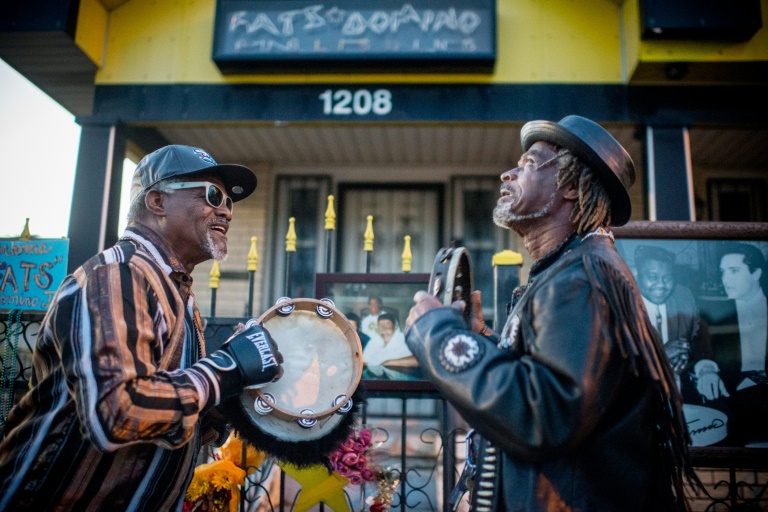Elroy Gelant shatters 31-year-old South African marathon record
Fats Domino's death marks the passing of an era in New Orleans, the city whose uniquely boisterous cultural brew created his sound -- and, with it, rock 'n' roll.
Domino, who died Tuesday at age 89, embodied “The Big Easy” on the Mississippi River like perhaps no other musician since jazz pioneer Louis Armstrong.
Despite his fame, he proudly livetin the working-class Lower Ninth Ward, returning after the area was devastated by Hurricane Katrina in 2005, and would generally end his concerts with a festive “When the Saints Go Marching In,” the city’s unofficial anthem.
Raised listening to the boogie-woogie pianists who packed New Orleans clubs, Domino became one of the top-selling acts of the 1950s and rivaled Elvis Presley as the King of Rock ‘n’ Roll.
But the self-effacing Domino once said: “Everybody started calling my music rock ‘n’ roll. But it wasn’t anything but the same rhythm and blues I’d been playing down in New Orleans.”
The city remains one of the foremost musical cities in the United States, a must-visit destination for aspiring jazz artists and whose tourism industry counts on the bustling jazz clubs of Bourbon Street.
Yet in a music scene dominated by large personalities, Domino’s death also marked an era’s end. His death came two years after another giant of New Orleans music, R&B composer Allen Toussaint, died at age 77 while touring Spain.
– ‘The G in gumbo’ –

Ricky Gettridge and Luqman Asadullah, lifelong friends of Fats Domino, sing and play tambourine to Domino songs at a memorial outside of his old home in New Orleans
Mourners gathered Wednesday night outside Domino’s modest home, lighting candles but also, in distinct New Orleans celebratory fashion, singing his music to the beat of tambourines.
“I guess you could say he put the G in gumbo,” said Lamar Smith Jr., 64, a longtime friend of Domino and owner of a Creole-style chicken wing shop, referring to the city’s signature spicy stew.
Smith, who hung a portrait of Domino alongside Presley at the makeshift memorial, said the pianist like Armstrong had managed to transcend racial lines through music.
Smith remembered how the rocker would treat all children when the ice-cream truck passed by.
“He was so humble and never let stardom get in the way,” Smith said. “He could have lived anywhere but there is something about our culture in New Orleans — the flavor, the food, the Southern hospitality — that he said you couldn’t get anywhere else.”
– Mix of cultures –
The port city owes its rich musical heritage to its vibrant cultural mix. Founded by the French and ruled by Spain, the city has soaked in influences from Africa, the Caribbean, Europe and more recently Asia.
Music has always been integral to the city, which was the opera capital of the United States in the 1800s and by the end of the 19th century became the birthplace of jazz.
Domino’s piano owed a debt to the blues, which came from African Americans in the Deep South, while his songs’ horn arrangements by Dave Bartholomew brought in Cuban and other Caribbean influences, said David Kunian, the music curator at the New Orleans Jazz Museum.
“I think his entire musical persona and everything he did was about New Orleans and rooted in New Orleans,” Kunian said.
Kunian said that rock pianists today from Elton John to Lady Gaga could all be seen as legacies of Domino’s arrangements.
“They’re much better than just this, but from a certain perspective you can look at The Beatles and say they were a Fats Domino cover band,” he said.
While no New Orleans artist today has such overwhelming influence, the city still has its share of world-famous musicians.
Top names in jazz include many with roots in New Orleans such as Terence Blanchard, Irvin Mayfield and Kermit Ruffins.
“The world lost an incredible New Orleans legend,” Mayfield tweeted.
Dr. John may be stylistically the closest New Orleans inheritor of Domino, while the city has also produced R&B singers The Neville Brothers and old-style pop pianist Harry Connick, Jr.
New Orleans has also set off a more recent cultural phenomenon in bounce, the energetic subset of hip-hop known for its raw sexuality including the buttock-thrusting dance style of twerking.
New Orleans still retains its influence “but it comes in more subtle ways,” Kunian said.
“There is great rock ‘n’ roll here. It’s not necessarily that you will listen to it and say, ‘That’s New Orleans,’ but it’s all informed by the New Orleans aesthetic.”
Download our app